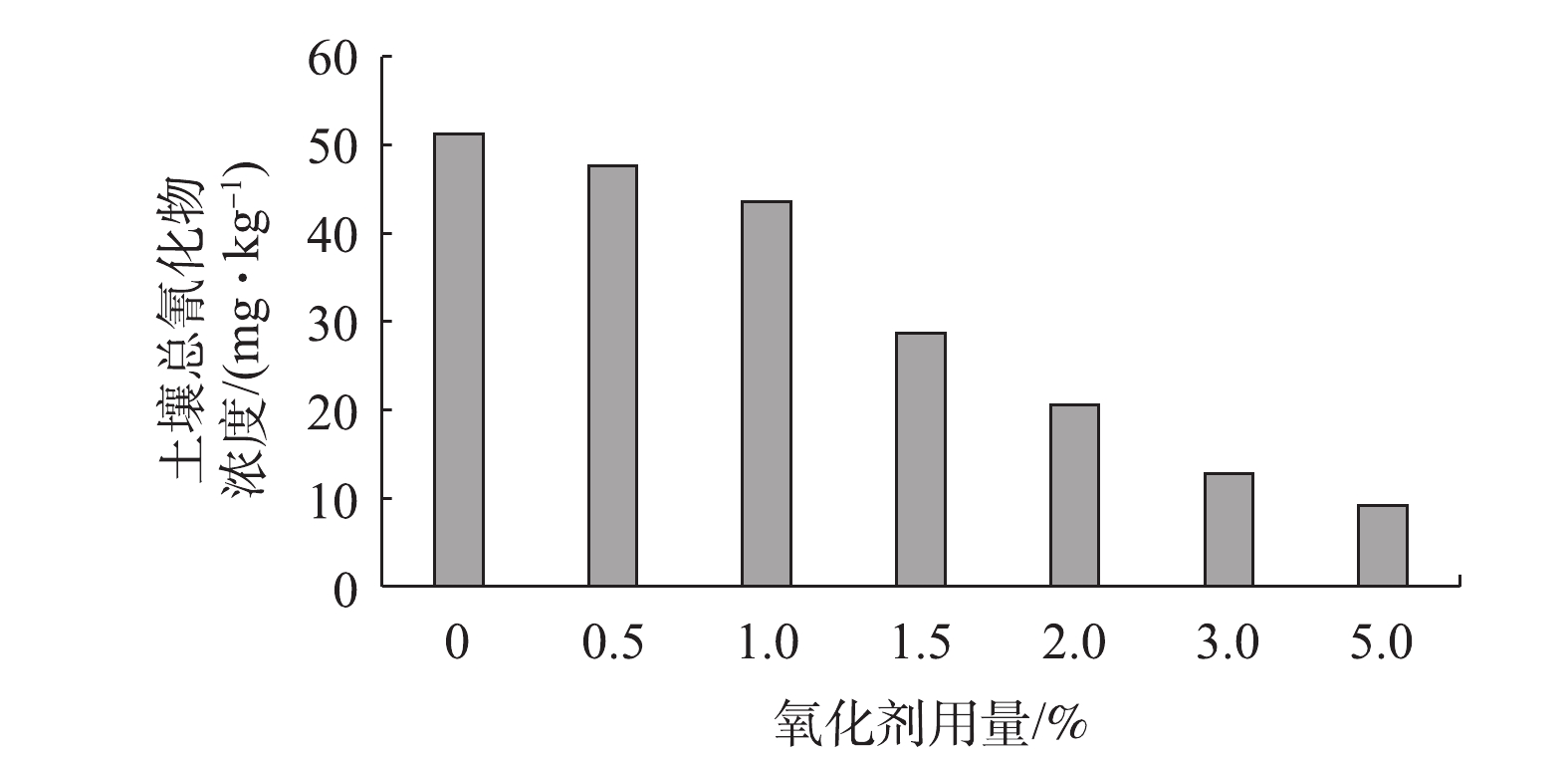-
氰化物被广泛应用于电镀、冶金、热处理、焦化和制革等行业。对相关行业企业退役场地土壤环境调查后发现,氰化物是首要这些场地的污染物[1-3]。常见氰化物分为简单氰化物和络合氰化物2种。在工业生产中,一般使用简单氰化物,其残留物进入土壤环境后,易与土壤中的金属元素发生络合反应,因此,土壤中氰化物形态以络合氰化物为主,如铁氰络合物等。虽然络合氰化物与简单氰化物相比毒性较低,但由于其化学性质更加稳定,修复难度更大。
常用氰化物污染土壤修复技术主要有水泥窑热解技术、化学氧化技术、淋洗技术、电动技术、固化稳定化技术和微生物技术等[4-6]。在国内,氰化物污染土壤修复工艺多采用水泥窑协同处置技术,如苏州机械仪表电镀厂原址污染土壤修复项目、重庆紫光化工公司永川分厂污染土壤修复项目、重庆兰科化工生产场址污染土壤修复项目等。其他类型修复技术还停留在实验阶段,暂时未见实际工程案例的报道。
天津某氰化物污染场地有数十万吨氰化物污染土壤。该项目原采用水泥窑热解技术进行处理,受水泥窑产能及重污染天气限产限运等因素限制,修复工程进展缓慢。本研究以该场地被污染土壤为研究对象,尝试采用氧化淋洗联合使用的工艺方法,研究在不同工艺条件下氰化物形态转变与修复效果之间的关系,优化筛选最佳工艺条件,并应用于工程实践,以期为国内同类项目提供借鉴和参考。
全文HTML
-
天津某氰化物污染场地采用异位修复的策略,按照土壤中氰化物浓度的差别分为轻度(9.86~96 mg·kg−1)、中度(96~350 mg·kg−1)、以及重度(350 mg·kg−1以上)污染土壤分类安全暂存。其中,中度、重度污染土壤占比约30%,优先采用水泥窑热解技术进行修复。本研究对象为总氰化物浓度9.86~96 mg·kg−1的轻度污染土壤。
-
修复后土壤最终用于回填利用。综合考虑人体健康风险和对回填区域地下水环境影响,修复目标采用污染物总量和浸出毒性双重控制标准:既满足修复后土壤中总氰化物含量低于9.86 mg·kg−1,又满足土壤浸出液中总氰化物浓度低于0.1 mg·L−1(Ⅳ地下水质量标准)。土壤浸出方法参考《固体废物浸出毒性浸出方法 硫酸硝酸法》(HJ/T 299-2007)。土壤中总氰化物和易释放态氰化物的检测方法参考《土壤 氰化物和总氰化物的测定 分光光度法》(HJ 745-2015);土壤浸出液中总氰化物的检测方法参考《水质 氰化物的测定 容量法和分光光度法》(HJ 484-2009)。
-
综合分析各种修复技术的优缺点,同时考虑本项目的实际应用情况,对修复时间、周边现有设施情况、修复成本和修复目标可达性等因素进行分析(表1)。由对比分析结果可知,现有条件下,化学氧化技术和土壤淋洗技术最适合该污染场地轻度氰化物污染土壤(9.86~96 mg·kg−1)的修复。本研究将重点考察这2种技术的修复效果,为确定实际修复工艺做参考。
1.1. 目标修复场地的土壤污染状况
1.2. 修复目标
1.3. 修复技术筛选
-
土壤修复中最常用的氧化剂为过硫酸盐,过硫酸盐与氰化物的反应机理见式(1)~式(3)。
反应过程:过硫酸盐在铁离子作用下活化为硫酸根自由基;硫酸根自由基在碱性条件下转化为氧化能力更强的羟基自由基;氰化物在羟基自由基的亲核进攻作用下,被分解转化为二氧化碳和氨气[7-9]。
实验方法:将从现场取回的氰化物污染土壤干燥后研磨,并过100目分样筛;称取100 g氰化物污染土壤于烧杯中,调节土壤含水率至40%,加入称量好的过硫酸钠搅拌均匀,氧化反应时间为7 d;考察过硫酸钠用量为1%、1.5%、2%、3%、5%的条件下,土壤中总氰化物和易释放氰化物的含量以及土壤浸提液中总氰化物的含量变化。
-
1)氧化剂用量对土壤中氰化物形态的影响。通过考察氧化后土壤中易释放氰化物和总氰化物的浓度,分析土壤中氰化物的形态变化。易释放态氰化物主要以简单氰化物为主,包括碱金属和碱土金属的氰化物。总氰化物中除了易释放态氰化物以外,还包括络合态氰化物,主要为铁氰化物、亚铁氰化物、铜氰络合物、镍氰络合物和钴氰络合物等。由图1可知,氧化前土壤中氰化物主要以络合态为主,占比达到85%;随着氧化剂用量的增加,土壤中易释放态氰化物出现明显的增加;在氧化剂用量在2%以上时,易释放态氰化物占比从氧化前的15%增加到84%。
分析其原因,氧化反应过程中,羟基自由基优先进攻键能相对较低、氰化物与络合金属之间的配位键,先将氰化物从络合形态释放出来,而后羟基自由基才去进攻键能较高的、氰化物内部的共价键。以土壤中含量最高的铁氰络合物为例,铁氰化亚铁的稳定结构被破坏后,6个氰根被释放出来,转化成了简单氰化物[10-12](图2)。
2)氧化剂用量对土壤总氰化物去除效果的影响。实验用土的总氰化物初始浓度为51.2 mg·kg−1。氧化剂用量与土壤总氰化物去除率之间的关系如图3所示。图3表明,在氧化剂用量在1%和3%处存在2个拐点。分别将曲线分为缓慢上升段(氧化剂用量<1%)、快速上升段(1%<氧化剂用量<3%)、以及平稳段(氧化剂用量>3%)3个区间。分析原因如下:在氧化剂用量为0~1%时,由于过硫酸钠活化后产生的羟基自由基优先进攻土壤中其他还原性物质[13-16],如有机质等,作用于氰化物的比例较小,故随着氧化剂用量的增加,总氰化物去除率变化不明显;随着氧化剂用量的进一步加大,土壤中还原性高于氰化物的物质被消耗殆尽,氰化物浓度呈现快速下降趋势;在氧化剂用量超过3%以后,由于转化率的提升(表现为土壤中剩余总氰化物浓度下降),氧化反应速率下降,氰化物的去除率趋于稳定。在氧化剂用量为3%时,土壤中总氰化物去除率已达75%以上;而氧化剂用量为5%时,去除率仅提高至82%,土壤中总氰化物浓度降低至9.23 mg·kg−1(见图4),满足9.86 mg·kg−1的修复目标。
3)氧化剂用量对土壤浸提液总氰化物去除效果的影响。随着氧化剂用量的增加,土壤浸出液中总氰化物的浓度呈现先增加后降低的趋势(见图5)。在氧化剂用量较低时,化学氧化的解络合作用占主导,对氰化物的氧化分解作用较弱。由于解络合后产生的易释放态氰化物水溶性更强,所以出现了浸出液中总氰化物浓度升高的情况;随着氧化剂用量的增加,氧化分解作用占据主导地位,故土壤浸提液中总氰化物浓度逐渐下降,该规律与已有研究的结果[16]相一致。在氧化剂用量为5%时,去除率仅为52%,土壤浸提液中总氰化物浓度从1.6 mg·L−1降低至0.79 mg·L−1,但距离0.1 mg·L−1的修复目标有较大差距。
根据氰化物污染土壤的氧化实验结果,化学氧化对土壤中总氰化物的去除效果较好,去除率可达82%,并满足9.86 mg·kg−1的修复目标值;而化学氧化对土壤浸提液中总氰化物的去除效果较差,去除率仅为52%,远未达到0.1 mg·L−1的修复目标。
2.1. 实验方法
2.2. 化学氧化技术处理效果
-
为考察氰化物在土壤中的吸附解吸性能,取2 g污染土壤于离心管内,加入20 mL水后进行封盖;按此制备10支离心管试样,放入摇床内振荡;分别在振荡10 min、30 min、1 h、2 h、4 h、8 h、16 h、24 h、48 h、72 h时各取出1支离心管进行离心处理,获得上清液;测试上清液中的总氰化物浓度。
为考察氰化物污染土壤的多次洗脱效果,按上述条件制备离心管试样,固定振荡时间为48 h,离心后分离出全部上清液;而后再加入20 mL水,并振荡48 h后离心分离上清液;重复洗脱5次,测试每次洗脱后土壤中总氰化物和易释放氰化物的含量,以及土壤浸提液总氰化物的浓度。
-
通过振荡淋洗实验,考察土壤中氰化物的吸附解吸性能(见图6)。分别用准一级动力学方程(式(4)和准二级动力学方程(式(5))对实验数据进行拟合[13-15]。
式中:qt和qe分别为t时刻和淋洗达到平衡时的淋洗量,mg·kg−1;k1为一级淋洗速率常数,min−1;k2为二级淋洗速率常数,kg·(mg·min)−1。
在振荡淋洗实验中,0~1 h内土壤总氰化物去除率快速提高。振荡淋洗1 h时,土壤总氰化物去除率达到30%以上;1 h以后土壤氰化物去除率提高缓慢。这是由于在淋洗初始阶段,土壤中的氰化物和淋洗液可以充分接触,而易释放态氰化物以溶解性较强的碱金属氰化物为主,所以易释放态氰化物优先迁移到液相中。当淋洗时间超过1 h后,易释放态氰化物基本迁移完毕,络合态的氰化物迁移较慢,需较长时间达到吸附解吸平衡。振荡48 h后,氰化物去除率达到50%。利用准一级动力学方程和准二级动力学方程均可较好地拟合淋洗液对土壤中总氰化物的淋洗动力学过程,相关系数均在0.95以上。
固定振荡淋洗时间为48 h,考察不同淋洗次数对土壤中总氰化物的去除影响(见图7)。针对初始浓度为51.2 mg·kg−1的氰化物污染土,振荡淋洗3次后,总氰化物可降低至10.2 mg·kg−1,接近土壤氰化物总量修复目标值。
振荡淋洗后,土壤中剩余氰化物的存在形态如图8所示。振荡淋洗后,土壤中的易释放态氰化物含量明显下降,且以首次淋洗时下降最多。这是由于以简单氰化物为主的易释放态氰化物更易于向淋洗液中迁移,而淋洗过程中以物理变化的吸附解吸过程为主,故氰化物各形态之间基本未发生相互转化。
如图9所示,淋洗过程对于土壤浸提液中总氰化物浓度的影响较大,原土浸提液浓度为1.6 mg·L−1。首次淋洗后即下降至0.34 mg·L−1,去除率接近80%;淋洗3次时,即可达到0.04 mg·L−1,满足0.1 mg·L−1的修复目标值。
氰化物污染土壤淋洗实验结果表明,淋洗对土壤中总氰化物的去除效果一般。单次淋洗后,土壤总氰化物去除率不超过50%,且随淋洗次数的增加,去除率呈现下降趋势。淋洗对土壤浸提液中总氰化物的去除效果较为明显。单次淋洗后,土壤浸提液总氰化物去除率接近80%。
3.1. 实验方法
3.2. 淋洗技术的处理效果
-
应用化学氧化技术,在合适的药剂用量(3%以上)和反应条件(反应时间7 d以上)下,土壤中总氰化物去除率达到80%以上;但氧化过程也会导致土壤中易释放氰化物比例增加,不利于土壤中浸提液中总氰化物浓度的去除,最优条件下去除率仅为52%。
应用淋洗技术,在单次淋洗条件下,土壤中总氰化物的去除率小于50%;而由于易释放态氰化物更易于向水相中迁移,单次淋洗后土壤浸提液中总氰化物浓度去除率达到80%。
按照土壤中总氰化物和土壤浸提液中总氰化物的双重修复目标要求,由于氧化技术对土壤总氰化物去除效果好、淋洗技术对土壤浸提液中总氰化物去除率高,故在天津某氰化物污染场地土壤修复项目中结合2种技术的优势,以较低成本实现修复达标是可行的。
-
按照氧化淋洗联合应用的技术思路,在天津某氰化物污染土壤治理项目进行工程应用。工程实施分为氧化单元和淋洗单元,工艺实施路线如图10所示。
1)氧化单元实施方案。将污染土从暂存区短驳进入修复区,在封闭的钢结构罩棚内完成土壤的预处理筛分破碎工作,分离出土壤中的大块建筑垃圾,并针对分离出的大块建筑垃圾进行冲洗处理。将筛分破碎后的土壤在罩棚内完成氧化剂的拌和,加药量按照3%的质量比。加药后的污染土由装载机送入静置反应区,维持土壤含水率30%~40%养护7 d后进行自检,自检合格后进入淋洗单元。
氧化单元的自检合格标准:土壤中总氰化物含量小于15 mg·kg−1(按照淋洗对总氰化物的去除率为50%,修复目标值为9.86 mg·kg−1,反推设计自检合格标准)。
2)淋洗单元实施方案。氧化自检合格的污染土壤进入淋洗单元,分别经过滚筒洗涤器、水力旋流器、螺旋洗砂机环节进行清洗,在滚筒洗涤器处分离出>2 mm的砂石,同时在螺旋洗砂机处分离出50 μm~2 mm粗砂,经板框压滤后分离出<50 μm的土壤颗粒。淋洗和冲洗环节产生的污水进入污水处理装置进行破氰处理,处置合格后作为淋洗液循环使用。淋洗单元土水比控制在1∶5左右。
淋洗单元出料砂石合并进入建筑垃圾冲洗环节。对出料的细粒土壤和粗砂进行自检,自检合格后申请验收。
淋洗单元的自检合格标准:土壤中总氰化物含量小于9.86 mg·kg−1,土壤浸提液中总氰化物含量小于0.1 mg·L−1,即满足本项目的最终修复目标值。
-
对经氧化淋洗联合修复后、且自检合格的土壤进行修复效果评估。以500 m3为1个检验批,在每个检验批土堆的表层、中层、底层以及不同位置,分别采集9个样品制成1个混合样送检。在对同一阶段处理的约2×104 m3氰化物轻度污染土壤进行验收,共采集44组土壤样品(含4组平行样),检测结果如表2所示。40个检验批土壤均达到双重验收指标的控制要求,合格率达到100%。
4.1. 氧化和淋洗联合应用的可行性
4.2. 实施方案
4.3. 修复效果评估
-
1)在氧化条件下,随着氧化剂用量的增加,土壤中总氰化物呈现下降的趋势,土壤中氰化物的形态从络合态向易释放态转变,土壤浸提液中总氰化物的浓度呈现先升高后降低的趋势;当氧化剂用量为5%时,总氰化物浓度从51.2 mg·kg−1降低至9.23 mg·kg−1,满足总量的修复目标,而土壤浸提液浓度从初始的1.6 mg·L−1降低至0.79 mg·L−1,未能达到修复目标。
2)在振荡淋洗条件下,对土壤淋洗5次。随着淋洗次数的增加,土壤中总氰化物呈现下降的趋势,土壤中氰化物的易释放态逐渐减少,土壤浸提液中总氰化物浓度呈现快速下降的趋势;在淋洗3次时,土壤浸提液浓度从初始的1.6 mg·L−1降低至0.04 mg·L−1,达到修复目标,而土壤总氰化物含量从51.2 mg·kg−1降低至10.2 mg·kg−1,未能达到修复目标。
3)氧化技术和淋洗技术联合使用时,在氧化剂用量为3%,淋洗1次条件下,土壤氰化物可以满足总量(9.86 mg·kg−1)和浸出(0.1 mg·L−1)的双重修复目标。
4)本研究成果已成功应用于天津某氰化物污染场地修复项目。土壤修复成本与原水泥窑热解处置成本基本持平。本技术的应用加快了该项目实施进程,对于降低修复工程的邻避效应风险和二次污染风险发挥了重要作用。研究成果和应用案例可为今后国内其他同类项目提供经验借鉴和技术参考。





 DownLoad:
DownLoad:












